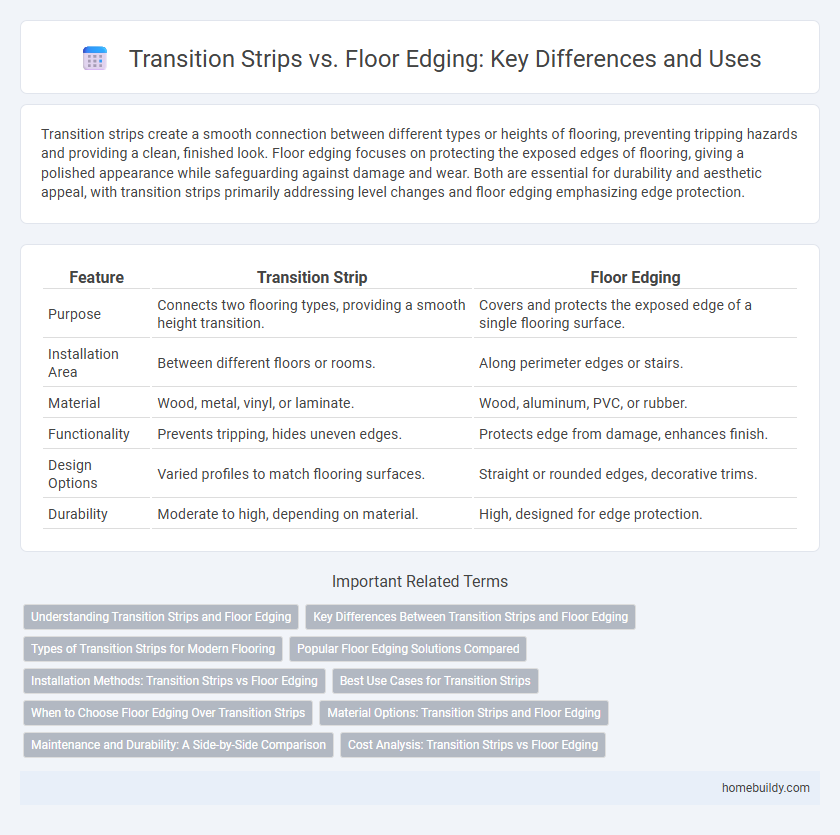Transition strips create a smooth connection between different types or heights of flooring, preventing tripping hazards and providing a clean, finished look. Floor edging focuses on protecting the exposed edges of flooring, giving a polished appearance while safeguarding against damage and wear. Both are essential for durability and aesthetic appeal, with transition strips primarily addressing level changes and floor edging emphasizing edge protection.
Table of Comparison
| Feature | Transition Strip | Floor Edging |
|---|---|---|
| Purpose | Connects two flooring types, providing a smooth height transition. | Covers and protects the exposed edge of a single flooring surface. |
| Installation Area | Between different floors or rooms. | Along perimeter edges or stairs. |
| Material | Wood, metal, vinyl, or laminate. | Wood, aluminum, PVC, or rubber. |
| Functionality | Prevents tripping, hides uneven edges. | Protects edge from damage, enhances finish. |
| Design Options | Varied profiles to match flooring surfaces. | Straight or rounded edges, decorative trims. |
| Durability | Moderate to high, depending on material. | High, designed for edge protection. |
Understanding Transition Strips and Floor Edging
Transition strips bridge gaps between different flooring types, ensuring a smooth and safe surface while accommodating height variations. Floor edging primarily protects and finishes the edges of a single flooring material, preventing damage and creating a clean border. Understanding the distinct roles of transition strips and floor edging helps optimize flooring durability and aesthetic continuity.
Key Differences Between Transition Strips and Floor Edging
Transition strips serve as connectors between different types or levels of flooring, ensuring a smooth and safe passage while preventing damage. Floor edging primarily functions to create a clean, finished border along the edges of flooring, providing aesthetic appeal and protecting the floor's perimeter from wear. The key differences lie in their purpose: transition strips bridge flooring transitions, whereas floor edging maintains edge integrity and design continuity.
Types of Transition Strips for Modern Flooring
Transition strips complement modern flooring by creating smooth, safe connections between different floor surfaces or levels. Types of transition strips include T-molding for connecting floors of the same height, reducer strips for transitioning from higher to lower surfaces, and carpet-to-hardwood strips specifically designed for seamless edges between carpet and hard flooring. Choosing the right transition strip enhances durability and aesthetic appeal while protecting floor edges from damage.
Popular Floor Edging Solutions Compared
Transition strips and floor edging both serve to create smooth visual and functional boundaries between different flooring types, but popular floor edging solutions such as T-molding, reducer strips, and stair nose profiles offer specialized fits for varying floor heights and transitions. Transition strips typically provide a seamless bridge between floors of equal height, while floor edging solutions like quarter round and baseboard trims enhance room aesthetics and protect flooring edges from damage. These variations cater to installation needs in areas ranging from hardwood to tile and laminate floors, ensuring longevity and a polished finish.
Installation Methods: Transition Strips vs Floor Edging
Transition strips typically install by snapping or screwing into a pre-attached track for seamless connections between different flooring types, while floor edging often requires adhesive application or nailing along the perimeter for a finished edge. Transition strip installation prioritizes flexibility to accommodate expansion and contraction, whereas floor edging focuses on securing the flooring edges to prevent damage. Both methods demand precise measurement and surface preparation to ensure durability and aesthetic appeal.
Best Use Cases for Transition Strips
Transition strips are ideal for bridging gaps between different flooring materials like tile to hardwood or laminate, providing a smooth and safe surface change. They excel in areas with varying floor heights or expansions gaps, preventing tripping hazards and floor damage. Unlike floor edging, transition strips accommodate movement and are perfect for doorways, room transitions, and areas where two different floors meet seamlessly.
When to Choose Floor Edging Over Transition Strips
Floor edging is ideal when creating a clean boundary between flooring and walls or carpet, especially in rooms with uneven subfloors. Unlike transition strips, which join two different flooring types or levels, floor edging provides a finished edge to prevent fraying or damage at the carpet's perimeter. Choose floor edging over transition strips when the goal is to protect and aesthetically finalize the carpet edge rather than bridge two flooring surfaces.
Material Options: Transition Strips and Floor Edging
Transition strips and floor edging offer diverse material options catering to various flooring needs. Transition strips commonly utilize materials like wood, aluminum, and vinyl, providing durability and aesthetic compatibility with hardwood, laminate, and tile floors. Floor edging often features rubber, metal, or PVC, designed to protect floor edges and create smooth boundary transitions, enhancing safety and longevity in high-traffic areas.
Maintenance and Durability: A Side-by-Side Comparison
Transition strips offer enhanced durability by absorbing floor movement and preventing edge chipping, making them easier to maintain over time compared to floor edging. Floor edging, while simpler in design, often requires frequent repairs or replacements due to vulnerability to wear and tear at floor joints. Proper installation of transition strips reduces maintenance costs and extends the lifespan of flooring transitions in high-traffic areas.
Cost Analysis: Transition Strips vs Floor Edging
Transition strips typically cost less than floor edging due to simpler installation and materials, making them a budget-friendly choice for seamless flooring transitions between different surfaces. Floor edging often involves more complex designs and durable materials, resulting in higher upfront costs but enhancing long-term floor protection and aesthetic appeal. Evaluating the total cost of ownership, transition strips offer immediate savings while floor edging may provide better durability and value over time.
Transition strip vs Floor edging Infographic

 homebuildy.com
homebuildy.com